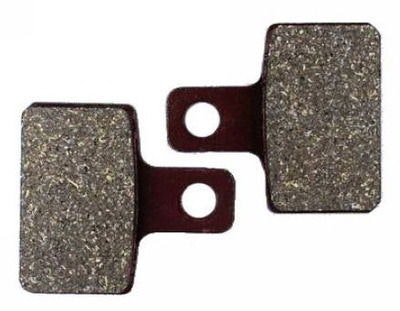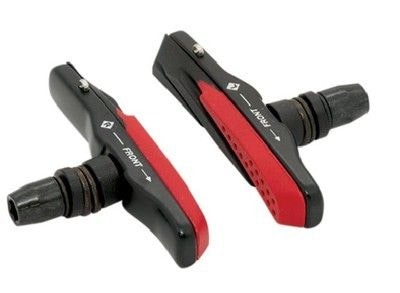Kids Bikes by Size (Height Range)
Popular Clothing Brands
Racks, Tools & Cleaning
Whether it's disc brakes or rim brakes and no matter the brand, chances are we have the right brake pads for you











Bicycle Brake Pads
Brake pads serve the purpose of slowing a bike down. A common wear item on any bike, there are many different types of brake pads and it's crucial that you find a suitable replacement for those that came with your bike originally. Once you have selected the correct fitment, then there are options to consider which will affect braking strength, finite control, noise reduction and/or durability.
Disk brakes work by pressing two disc brake pads against the rotor to slow or stop your bike. Rim brakes are commonly found on racing and road bikes as they’re lighter than standard disc brakes. However, they do not perform as well as disc brakes. Most other bikes (e.g., mountain bikes, commuting bikes, etc.) will have disc brakes as these have better stopping power.
If your bike has rim brakes (road brake callipers or mountain bike v-brake), you need to choose the appropriate bike brake pads. Rim brakes are usually made from a rubber compound, and with some v-brake pads, you have the option of only replacing the rubber pad insert.
Disc Brake Pads
Disc brakes consist of a disc rotor attached to the wheel's hub, and a brake calliper fixed to the frame or fork. This type of brake is common in mountain, urban and now even road bikes. There are dozens of brake pad shapes and sizes on the market today and so the most important aspect of choosing a replacement disc brake pad is to ensure it's an exact match with your brake calliper. Knowing the brand and model name of your brake pad should suffice, but if in doubt, you'll need to remove the old pad and ensure the shape and size are the same.
Disc brake pads are typically available in two material compounds – sintered metal or organic/resin. The sintered metal is typically considered the more durable option and offers greater braking power. The resin/organic options are softer and so will wear faster, however, they also typically are quieter and offer greater finite braking control.
Rim Brakes
Rim Brake pads are made from rigid and long-lasting rubber and are designed to contact the bicycle's rim for slowing. Like disc brake pads, it's important that you choose the right fitment for rim brake pads too. While many options exist, the two key types on the market are 'road brake calliper' and 'mountain bike v-brake' pads. Pictured below is a mountain bike 'v-brake' style pad.
Additionally, more expensive bikes are likely to use pad 'inserts' where the rubber aspect of the pad is replaceable separately to the pad holder. If your brakes have a clear pin or bolt holding just the rubber pad in place, then it's likely you can replace just the inserts.
How to choose bike brake pads?
There are many different options when it comes to choosing bike brake pads. The exact stopping power you require may depend on whether you’re using a road or mountain bike. The type of terrain you commonly encounter can also be a factor for the type of cycling brake pads that are most suited. When you first look at brake pads, you'll need to find those that fit your calliper and then decide what type of compound you'd prefer for your pushbike brake pads.
Brake pad shape
Your brake callipers will often determine the exact shape of your brake pads, and these are easy to work out by looking at your bike. Examine your brakes to find what it is called (this is usually marked on the calliper), and then you can find a brake pad that matches. If you can find the name on the brakes, you can take out the old pads and try to find a model number. If you haven't upgraded the calliper kit, you can look up the manufacturer of your bike, and they should have the information about your brakes and which brake pads are suitable.
Brake pad compounds
After you have the brake pad shape, the next factor you need to consider is the compound that is most suitable. The three main types of compounds are metal (also called sintered), semi-metal, and resin (or organic). There are positives and negatives for each of these types, and the one you choose can be based on what you find most beneficial.
Sintered or metallic. These are long-lasting brake pads made up of a mixture of metallic particles, and they can withstand higher temperatures.
Semi-metal. These pads are an excellent all-around brake pad, and they attempt to take the best parts of the metal and resin brake pads.
Resin or organic. The pads offer the shortest amount of time to bed in, and they are less noisy than other pads.
How long do bike brake pads last?
Knowing when to change or buy bicycle brake pads can be challenging. The exact timeframe for when your braking gear needs to be changed depends on if you're using a mountain bike or a road bike. However, to keep you safe on your bike and ensure your brakes function within reasonable limits, it is best to change them once they reach a thickness of under 1.5mm.
This thickness limit is a standard, and it may be possible to go under that depending on the type of compound in your brakes. For metal or semi-metal brakes, you'll find these are suited to use under 1.5mm, and they'll still be functional. If you're planning a long ride or touring, it may be best to take a spare set of bike brake pads and check them regularly.
With organic and resin brakes, you can expect them to last 900 to 1200 km before they need changing. If you're using metal brakes, you'll likely need to replace them 1600 to 2000km. The exact length will rely on how hard you brake while you're riding. So, for casual weekend rides, you may find the brakes lasting longer than during fast-paced rides. Other factors that play into how long your brakes will last include the terrain, climate, and your riding style.
How to install bike brake pads?
The method for changing your bike brake pads will depend on your calliper and other components. In most bikes, changing the pads should only take a few minutes, and it is best to consult your bike's manual. After you've removed the old brake pads, it is an excellent time to clean the calliper and check the cables or brake hoses for any wear.
After the brakes are cleaned, you can change the brake pads for bikes and make any adjustments as required. You should go for a short ride to test the performance of the brakes; you may find the calliper needs adjusting as the thickness of the brake pads has changed, and they may be tighter than you are used to, which can cause over braking.
BikeExchange is where you'll find all the best brake pads (for rim brakes and disc brakes) and other bike accessories in Australia. You can search our store for a selection of energy gels, handlebar tape, cycling computers, bottle cages, and clip-in pedals. We also have hundreds of listings for popular Liv mountain bikes, standard Liv bikes, and clothing and footwear for female and male cyclists. Shop now.




